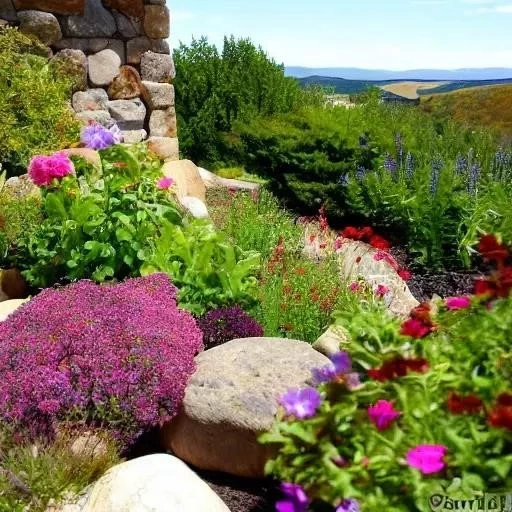
Today is 10/01/2025 11:52:31 ()
The quest for a truly distinguished outdoor space often leads homeowners down paths less traveled, away from generic lawns and towards landscapes brimming with character. In this exciting evolution of garden design, one trend is incredibly effective in marrying natural beauty with enduring elegance: the stone flower garden. This isn’t just about placing a few rocks; it’s about sculpting a living masterpiece, transforming mundane backyards into breathtaking sanctuaries that inspire awe and provide lasting joy. Far from being a fleeting fad, these resilient installations are rapidly becoming the gold standard for those seeking both aesthetic grandeur and practical longevity.
Imagine stepping into your garden, greeted by a vibrant tapestry of colors meticulously framed by the timeless strength of natural stone. This vision is not only achievable but remarkably accessible through thoughtful planning and a dash of DIY enthusiasm. By integrating careful design principles with readily available materials, anyone can embark on this rewarding journey, cultivating a personal paradise that stands firm against the elements. The beauty of a stone flower garden lies in its dynamic interplay: the rugged, earthy textures of granite or quartzite complementing the delicate, ever-changing hues of salvia and coneflowers, creating a captivating display that evolves with each passing season.
Key Elements & Essentials for Your Stone Flower Garden
| Category | Description | Reference/Best Practice |
|---|---|---|
| Location Selection | Choose a flat, well-draining area that receives ample sunlight for optimal flower growth. | Ensure proper water runoff and plant vitality. |
| Primary Stone Choices | Granite, quartzite, sandstone, argillite, river rock, flagstone, or even reclaimed brick for unique aesthetics. | Consider local availability and desired garden style (rustic, modern, formal). |
| Soil & Plant Selection | Install fresh, nutrient-rich garden soil. Opt for hardy perennial flowers like Russian Sage, Salvia, Walker’s Low Cat Mint, and Purple Coneflower. | Prioritize drought-tolerant and low-maintenance varieties suitable for your climate. |
| Construction Type | From simple borders and stacked stone edgings to robust raised beds and retaining walls. | Match the construction to your landscape’s needs and desired visual impact. |
| Foundation & Drainage | Excavate a trench (e.g., 12 inches wide, 4 inches deep), lay landscape fabric, and add a base layer of crushed stone or pea gravel. | Crucial for stability, weed prevention, and efficient water management. |
| DIY Inspiration Link | Explore creative ideas for painted rock flowers and stone arrangements. | Hometalk DIY Painted Rock Flowers Garden |
The foundation of any spectacular stone flower garden begins with meticulous planning. Expert landscapers consistently emphasize the importance of site selection. A flat, well-draining location bathed in plenty of sunlight is paramount for the health and vibrancy of your chosen flora. Once identified, marking the boundaries of your desired garden bed with marking paint allows for a clear visualization of the project’s scope. This initial mapping phase is incredibly effective, preventing costly adjustments down the line. Following this, excavating a trench—typically 12 inches wide and 4 inches deep—provides the crucial stable base for your stone elements, whether you’re envisioning a simple border or an elaborate raised bed.
Selecting the right stone is a pivotal step, dictating the character and longevity of your garden. California, for instance, sees popular choices ranging from the robust elegance of granite and quartzite to the earthy appeal of sandstone and argillite. For those aiming to minimize costs without compromising on visual impact, river rocks offer a rustic charm, while natural flat stones can be arranged closely together for a seamless border. By integrating diverse stone types, you can craft distinct zones, perhaps utilizing stacked stones for a raised flowerbed and flagstones for an adjoining walkway, creating a cohesive yet varied landscape. This thoughtful selection process transforms mere materials into architectural components, shaping the very soul of your outdoor haven.
Building the physical structure requires both precision and patience, yet remains an entirely rewarding DIY endeavor. For raised garden beds or retaining walls, techniques like laying cardboard, then stumps, before filling with soil, can improve drainage and soil health, as seen in many successful projects shared by gardening enthusiasts. When constructing stone walls, giving the stones a very slight slope inwards and using pebbles to prop them up ensures stability, a tip frequently shared by experienced hardscapers. Tools like a diamond-grit circular saw blade can assist in achieving precise cuts for natural rough-cut stone, blending seamlessly into the surrounding landscape and adding significant value to your property.
With the stone framework firmly established, the focus shifts to the living elements: the flowers. The success of a stone flower garden hinges on providing an optimal growing environment. Installing fresh, high-quality garden soil is non-negotiable, offering the essential nutrients for your plants to thrive. For a continuous display of color and texture, selecting hardy perennial flowers is key. Varieties like Russian Sage, Salvia, Walker’s Low Cat Mint, and Purple Coneflower are not only beautiful but also remarkably resilient, promising vibrant blooms season after season. Their enduring beauty, juxtaposed against the stoic permanence of stone, creates an unparalleled visual harmony, a testament to thoughtful design.
Embracing the stone flower garden revolution is more than just a landscaping project; it’s an investment in beauty, durability, and personal satisfaction. These stunning installations, from simple borders crafted from river rocks to elaborate raised beds constructed with natural rough-cut stone, offer a sustainable and visually captivating alternative to traditional gardening. They elevate your outdoor living experience, providing a serene backdrop for relaxation and a vibrant canvas for nature’s artistry. As industry experts like HGTV’s Mina Starsiak often advise, prepping your yard with durable, aesthetically pleasing borders is a smart move, enhancing curb appeal and ensuring long-term enjoyment. So, why wait? Transform your garden into a delightful paradise, a true testament to enduring beauty and your own creative spirit, starting today.
